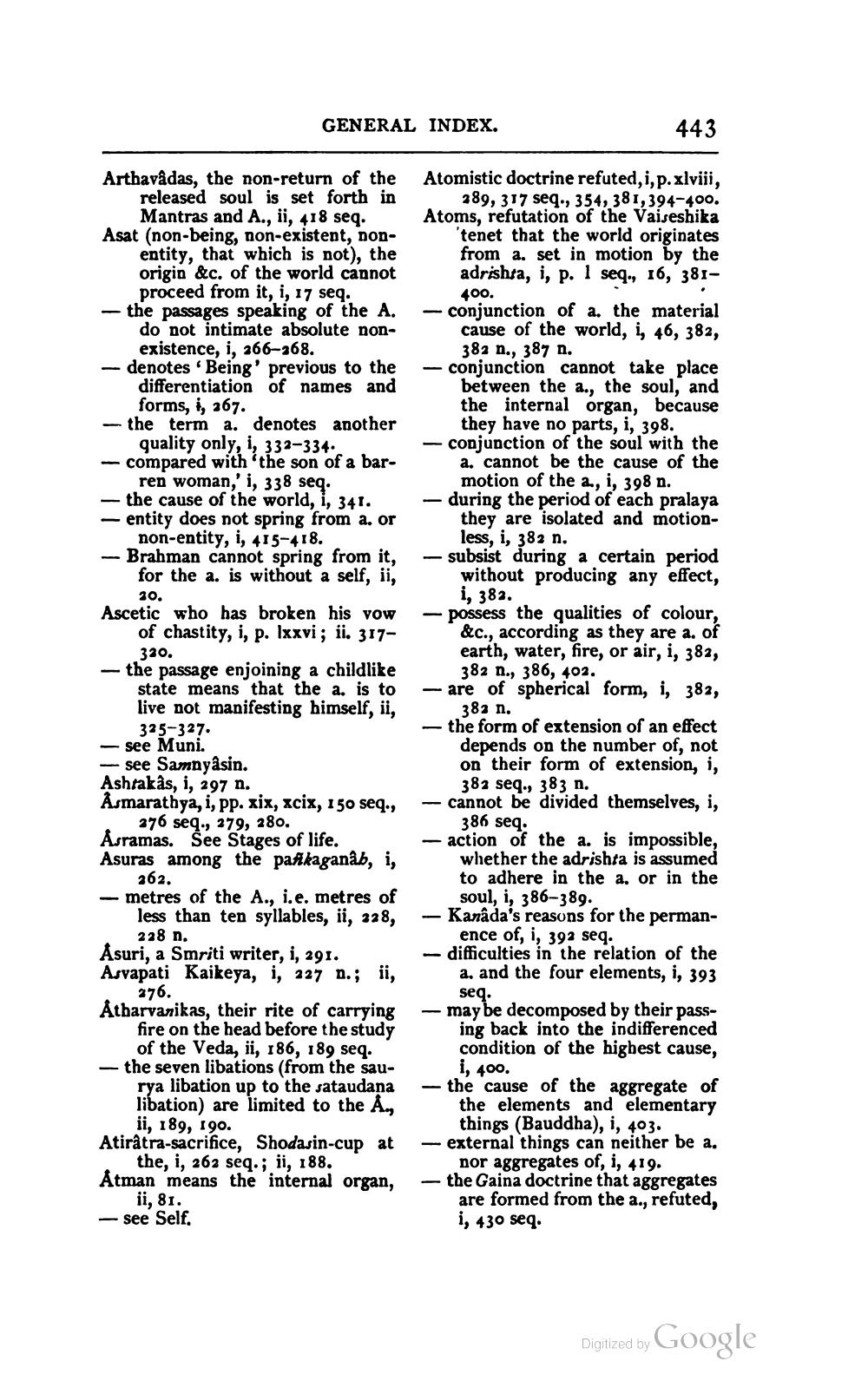________________
GENERAL INDEX.
443
400.
—
Arthavadas, the non-return of the
released soul is set forth in
Mantras and A., ii, 418 seq. Asat (non-being, non-existent, non
entity, that which is not), the origin &c. of the world cannot
proceed from it, i, 17 seq. - the passages speaking of the A.
do not intimate absolute non
existence, i, 366-368. - denotes Being' previous to the
differentiation of names and
forms, i, 267. - the term a. denotes another
quality only, i, 332-334. - compared with the son of a bar
ren woman,'i, 338 seq. the cause of the world, i, 341. entity does not spring from a. or
non-entity, i, 415-418. - Brahman cannot spring from it,
for the a. is without a self, ii,
10.
Ascetic who has broken his vow
of chastity, i, p. lxxvi; ii. 317
320. - the passage enjoining a childlike
state means that the a. is to live not manifesting himself, ii,
325-327. - see Muni. - see Samnyâsin. Ashtakås, i, 297 n. Asmarathya, i, pp. xix, xcix, 150 seq.,
276 seq., 279, 280. Asramas. See Stages of life. Asuras among the paflkaganåb, i,
262. - metres of the A., i.e. metres of
less than ten syllables, ii, 228,
228 n. Åsuri, a Smriti writer, i, 291. Asvapati Kaikeya, i, 227 n.; ii,
276. Atharvanikas, their rite of carrying
fire on the head before the study of the Veda, ii, 186, 189 seq. the seven libations (from the saurya libation up to the sataudana libation) are limited to the A,
ii, 189, 190. Atirâtra-sacrifice, Shodasin-cup at
the, i, 262 seq.; ii, 188. Atman means the internal organ,
ii, 81. - see Self,
Atomistic doctrine refuted, i, p. xlviii,
289, 317 seq., 354, 381,394-400. Atoms, refutation of the Vaiseshika
'tenet that the world originates from a. set in motion by the
adrishta, i, p. I seq., 16, 381- conjunction of a. the material
cause of the world, i, 46, 382,
382 n., 387 n. conjunction cannot take place between the a., the soul, and the internal organ, because
they have no parts, i, 398. - conjunction of the soul with the
a. cannot be the cause of the
motion of the a., i, 398 n. — during the period of each pralaya
they are isolated and motion
less, i, 382 n. - subsist during a certain period
without producing any effect,
i, 382. - possess the qualities of colour,
&c., according as they are a. of earth, water, fire, or air, i, 382,
382 n., 386, 402. - are of spherical form, i, 382,
383 n. the form of extension of an effect depends on the number of, not on their form of extension, i,
382 seq., 383 n. - cannot be divided themselves, i,
386 seq. - action of the a. is impossible,
whether the adrishta is assumed to adhere in the a. or in the
soul, i, 386-389. – Kanada's reasons for the perman
ence of, i, 392 seq. - difficulties in the relation of the
a. and the four elements, i, 393
seq. - may be decomposed by their pass
ing back into the indifferenced condition of the highest cause,
i, 400. - the cause of the aggregate of
the elements and elementary
things (Bauddha), i, 403. - external things can neither be a.
nor aggregates of, i, 419. - the Gaina doctrine that aggregates
are formed from the a., refuted, i, 430 seq.
Digitized by
Digized by Google




